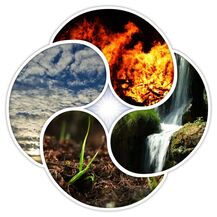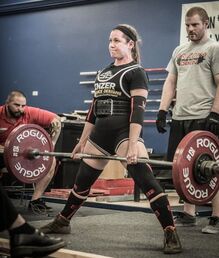|
Author: Emilia Wheaton Editor: Kristen Kennedy Smith Nope, not the 70’s pop band, but the elements that make up the three Ayurvedic Doshas. To fill you in, Ayurveda is the ancient Indian wisdom dedicated to improving health by balancing the body and mind through targeting our diet and activity according to each of our Doshas. In sanskrit, the word Dosha is synonymous to energy and each dosha is a combination of the five elements: earth, wind, fire, water and ether (or space). Each Doshas’ characteristics relate to both our mind and body, and when one area of our mind or body are out of balance, we can analyze our doshic makeup to find this imbalance and treat it accordingly. For example, if our Pitta dosha were unbalanced, we might experience a fiery temper and be soothed by cooling, hydrating foods like leafy greens and sweet, fresh fruit. Each of us has our own unique Doshic makeup that includes each of the three Doshas, though we may most closely resonate with one…
Vata = air + space We can think of the Vata energy to be like the wind; it is light, dry, cold and ever-moving. The Vata body is naturally thin, with a long face and dark complexion and small eyes, the skin is dry and often cold when others are warm. Without regular motion, Vata bodies become stiff and sore, Vata types are often very flexible and mobile. Movement is healing for Vatas, while they can become restless and uneasy if made to sit still for too long. Vatas are variable; they can be high-energy and feeling strong and capable one day then flip to feeling incredibly weak and fragile the next. This polarity requires stability, strength and balance to be the focal point of their exercise regime. As far as the Vata mind, it strikes the same chord along the need for movement of the Vata body. Their minds and moods can change rapidly, they are creative people with many ideas and inspirations. When Vata is in balance, they are social, innovative visionaries who inspire and motivate those around them. With excess Vata energy, these folks can be easily overwhelmed or agitated and have a hard time turning off the restless noise of their mind. The best foods for those with lots of Vata energy are grounding, warm foods, like stewed and spiced root vegetables. Eating too many raw, fibrous veggies can bother the weak digestive systems of Vatas, so they should stick to cooked, warm foods that are building and grounding. Pitta = fire + water The Pitta vibe is a fiery one… hot, sharp, powerful, transformative, and strong are attributes that all describe the Pitta energy. The physical build of Pittas is quite muscular and hearty, though they are of medium size and their weight is distributed evenly, they can have ruddy skin tones and have almond shaped eyes. Pitta skin can be more oily and sensitive; acne is often a Pitta’s problem. Pittas become overheated easily and are often sweating even with light exercise; they’re our friends wearing shorts and a tank by the fan while the rest of us are comfy in our jeans and long-sleeve shirts on a mild summer night. Pittas are often on the go, as they can overbook themselves and could really benefit from a lazy day filled with self care activities and a little rest and relaxation. They already run hot, just chill out Pittas. The Pitta mind is sharp and strong, they are driven go-getters who excel in leadership positions. They thrive under competition though they can be too hard on themselves which can bring them to anger or burn out before the job is done. They can be perfectionists and hold themselves and others to unreasonably hard standards, which can just cause frustration and resentment. It is important to keep Pitta energy in balance so as not to turn irritable, too competitive or chronically dissatisfied. Pittas have the strongest digestive system of all the Doshas, as the fire element works to break down fuel with ease. However, this digestive heat can backfire if they consume the warm, spicy rich foods they are naturally attracted to. Pittas should avoid caffeine and chocolate while choosing more simple, cooling foods like steamed veggies, substitute in coconut oils plus healthy soothing fats like avocado, and focus on sweet root vegetables. Kapha = earth + water The Kapha energy is cool, soft, steady, smooth and calm. Physically, Kaphas tend to have big, bright eyes, full lips and a curvy figure, they put on weight easily, and have naturally solid builds. While Vata is cold and dry, Kapha is cold and wet, so their skin is typically naturally well moisturized while they often have clammy hands. Kaphas have great endurance and can persist longer than any of the Doshas. With excess Kapha in our bodies, we may feel slow and sluggish, unmotivated to exercise or seek a change in scenery. Kaphas, because of the earth present in their dosha, tend to be well grounded and stable; however, this can backfire as Kaphas tend to have a hard time finding their way out of a negative situation as they may be slow to move toward a solution. Kaphas can be stuck in the past, reminiscing about days gone by and be hesitant to try new things or step out of their comfort zones. When Kapha energy is in balance, these folks are pleasant, content and happy individuals who bring friends together in safe space with their listening ear and welcoming nature. On the flip side, depression is a red flag for a Kapha imbalance; a lazy, resistant, and emotionally depleted person may benefit greatly from a little Vata air or Pitta fire. Kaphas have s l o w digestive systems and often feel bloated and overly full after a meal. Therefore, it is important that Kaphas avoid creamy, dense, thick and rich foods and instead fill their plates with light, leafy greens and herby legumes. To cater to their slow digestion, Kaphas may benefit from eating fewer meals, cleanses or intermittent fasting. Kaphas put on weight very easily and have a hard time losing it, so it can be important for Kaphas to maintain a healthy diet and include steady, light exercise in their daily life rather than vault towards an intimidating exercise regime. Each of us is a blend of the Doshas; none of us are comprised of solely one energy, so we must work to achieve a balance between our Pitta, Kapha and Vata sides. If we feel out of balance, we can relate back to the Doshic energies to level out the inequity. The science of Ayrveda is certainly not a new one, the wisdom is old; incorporating Ayurvedic wisdom to our daily lives is one way to blend Western medicine with Eastern in an attempt to be full, well rounded and healthy bodies and minds. Where do you feel your Doshas align or are out of balance? Need to know more? Tune in to the Old Soul Millennial Podcast on Spotify or the Apple Podcast App; Episode 15 unveils the ins and outs of the three Doshas. Sources: Eat, Feel, Fresh by Sahara Rose ayurvedichealthcenter.com
1 Comment
Blog Writer: Emilia Wheaton Blog Editor: Kristen Kennedy Smith Photo Credit: Tucson Strength When you think of yoga do you envision impossible contortions, ancient India, or Instagram models yoga posing on white sand beaches? It can be all of those things, sure, but many may not envision the physical, mental and emotional benefits a yogic practice can impart on the bodies and minds of Powerlifters. Competitive lifters, in particular, can benefit from the therapeutic stretching and present-mindedness that come along with yoga.
Yoga combines physical postures with intentional breath work, which work in conjunction to bring us mind-body awareness. Powerlifters can practice this breath-movement union and apply it to their competitive lifting. The presence of mind achieved by yoga can directly translate to other aspects of our life, namely the moments in which we are on the platform, when we need to be completely present and aware of every muscle’s interaction as we squat, bench press or deadlift. Harnessing the breath while deadlifting, for example allows our concentration to narrow on just our body and our breath working as one to accomplish our physical goals. Yogic theory also adapts its own version of the yin and yang principle, where all powerful, strenuous, taxing energy be compensated with a restorative, flexible, softness. If Powerlifting is the yang in this case, yoga can provide the counterbalancing yin to both soothe our stressed and contracted muscles while reinforcing musculature that is not targeted by lifting. Building muscle requires for the muscle to heal and stretch, which yoga is perfect for. In fact, according to this study, “certain yoga techniques may improve physical and mental health through the down-regulation of the hypothalamo pituitary adrenal (HPA) axis and the sympathetic nervous system.” Involving yoga in our lives is a holistic approach to managing the stress of our daily lives and the physical stress of our powerlifting careers. Let’s break this down. This HPA axis thingy that I don’t remember hearing about since 12th grade biology? The scientists behind this book describe the HPA axis as being responsible for our reactions to stress and regulating digestion, the immune system, mood and sexuality and (drumroll please) energy usage! Lifting is very much a sport where energy must be harnessed and then pushed to explode as we complete a lift. Yoga’s benefits for the HPA axis then translate to an improved ability to use our energy most efficiently and appropriately as we (“lift”). Yoga can truly be used as an effective practice for stressful lifestyles and for the physiological stress athletics put on our body. Through yoga, we are able to regulate our stress responses, improve our mood, and find mind-body awareness while at the same time soothing and building the muscles so integral for intense sports like powerlifting. Balancing the rigid with the flexible will bring peace, security, empowerment and a newfound way of caretaking our bodies which we expect so much from. Reach out to us to learn more about our approach to yoga for Powerlifters, our class schedule, and other resources! |
AuthorAbout the Editor: Archives
January 2021
Categories |




 RSS Feed
RSS Feed
